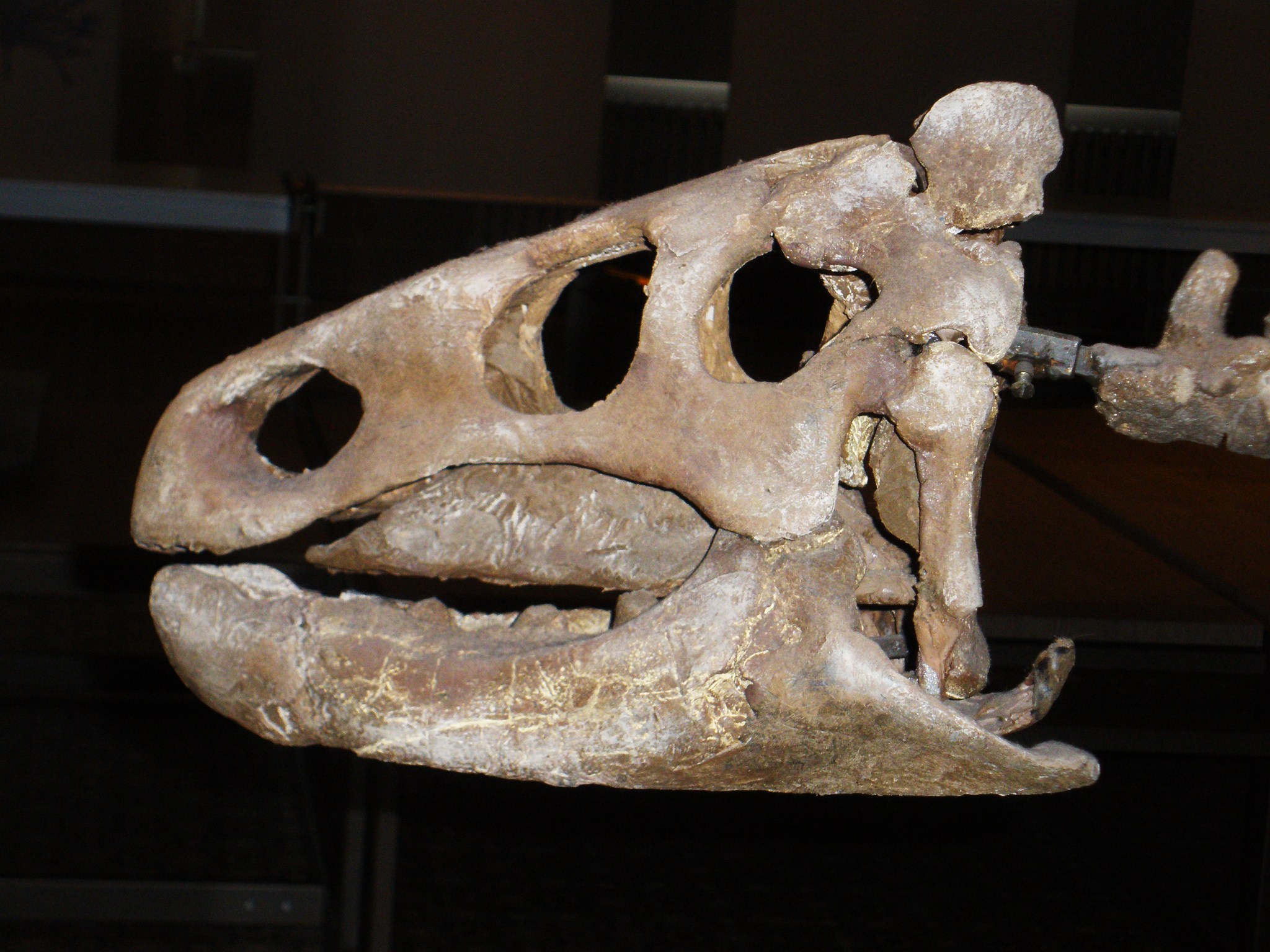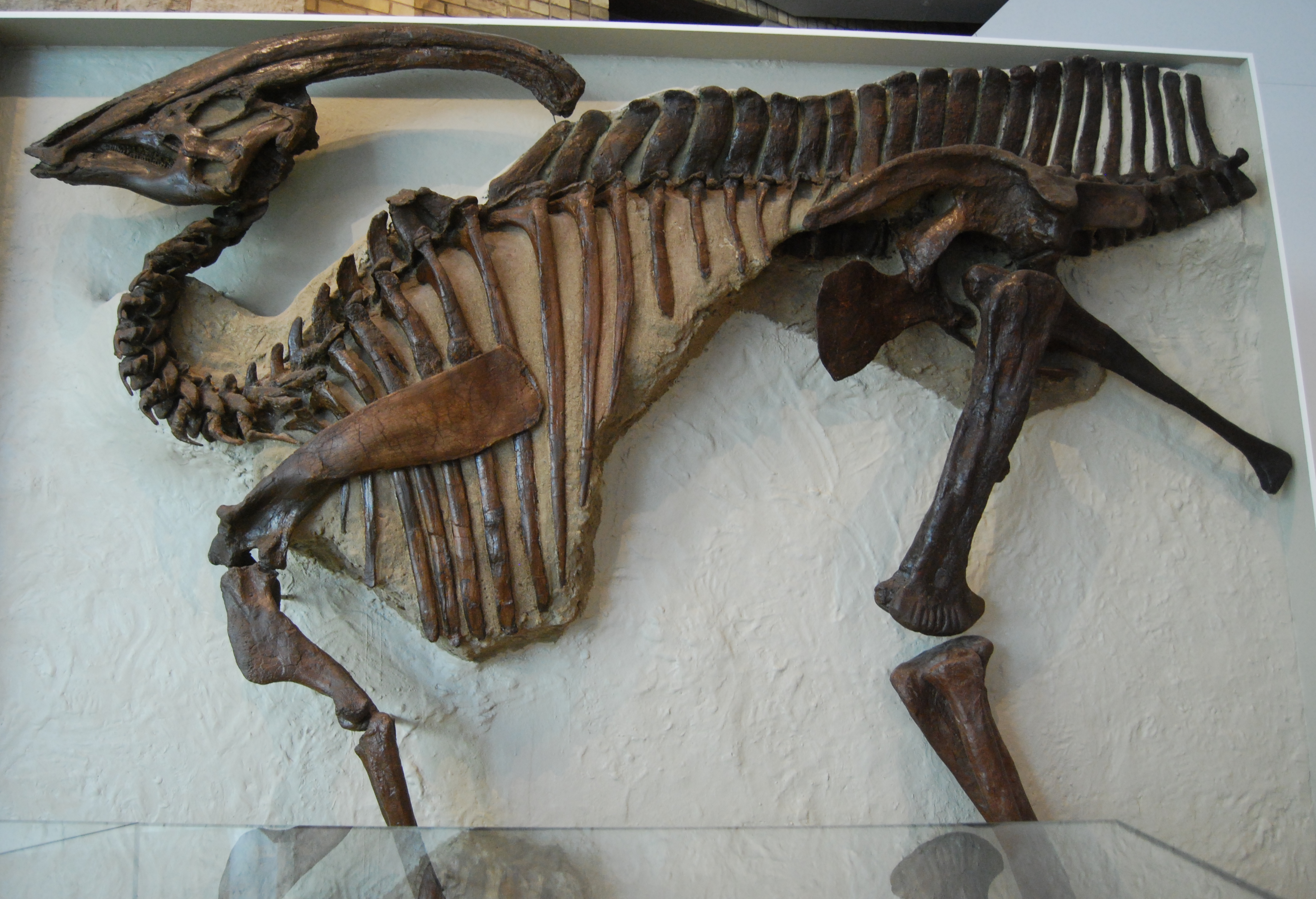|
Rhabdodontidae
Rhabdodontidae is a family of herbivorous iguanodontian ornithopod dinosaurs whose earliest stem members appeared in the middle of the Lower Cretaceous. The oldest dated fossils of these stem members were found in the Barremian Castrillo de la Reina Formation of Spain, dating to approximately 129.4 to 125.0 million years ago. With their deep skulls and jaws, Rhabdodontids were similar to large, robust iguanodonts. The family was first proposed by David B. Weishampel and colleagues in 2003. Rhabdodontid fossils have been mainly found in Europe in formations dating to the Late Cretaceous. The defining characteristics of the clade Rhabdodontidae include the spade-shape of the teeth, the presence of three or more premaxillary teeth, the distinct difference between the two maxillary and dentary teeth ridge patterns, and the uniquely shaped femur, humerus, and ulna. Members of Rhabdodontidae have an adult body length of 1.6 to 6.0 meters. Description Teeth Rhabdodontids have a s ... [...More Info...] [...Related Items...] OR: [Wikipedia] [Google] [Baidu] |
Zalmoxes
''Zalmoxes'' is an extinct genus of rhabdodontid ornithopod dinosaur from the Maastrichtian of Romania. The genus is known from specimens first named as the species '' Mochlodon robustum'' in 1899 by Franz Nopcsa before being reclassified as ''Rhabdodon robustum'' by him in 1915. In 1990 this name was corrected to ''Rhabdodon robustus'' by George Olshevsky, and in 2003 the species was once more reclassified, this time as the type species ''Zalmoxes robustus''. ''Zalmoxes'' refers to the Dacian deity Zalmoxis, and ''robustus'' to the robustness of the remains. In 2003 another species was named, ''Zalmoxes shqiperorum'', named for the Albanian name for Albanians. History of discovery ''Zalmoxes'' was first known from numerous fossils found in Transylvania, which were named as the species '' Mochlodon robustus'' by Baron Franz Nopcsa in 1899. The specific name referred to its robust build. In 1915 Nopcsa renamed the species as ''Rhabdodon robustum'', amended by in 2003 b ... [...More Info...] [...Related Items...] OR: [Wikipedia] [Google] [Baidu] |
Mochlodon Vorosi
''Mochlodon'' is a genus of rhabdodontid dinosaurs from the Late Cretaceous of Austria and Hungary. It lived during the Late Cretaceous (85-80 Ma) and two species are known: ''M. suessi'' and ''M. vorosi''. Discovery and species In 1859 coal mine administrator Pawlowitsch notified the University of Vienna that some fossils had been found in the ''Gute Hoffnung'' mine at Muthmannsdorf in Austria. A team headed by geologists Eduard Suess and Ferdinand Stoliczka subsequently uncovered numerous bones of several species, among them those of a euornithopod dinosaur. Stored at the university museum, the finds remained undescribed until they were studied by Emanuel Bunzel from 1870 onwards. Bunzel in 1871 named the euornithopod a new species of ''Iguanodon'': ''Iguanodon suessii''. The specific name honours Suess and is today more often spelled ''suessi''. In 1881 Harry Govier Seeley named a separate genus: ''Mochlodon''. The generic name is derived from Greek ''mokhlos'', "bar", and ... [...More Info...] [...Related Items...] OR: [Wikipedia] [Google] [Baidu] |
Matheronodon
''Matheronodon'' (meaning "Matheron tooth") is a genus of rhabdodontid ornithopod dinosaur from the late Cretaceous Period of the Grès à Reptiles Formation in France. The genus contains a single species, ''M. provincialis'', which is known from a single maxilla and associated teeth. It was named by Pascal Godefroit and colleagues in 2017. The teeth of ''Matheronodon'' are large but few in number. The teeth are also in an unusual arrangement, emerging alternatingly from one of a pair of fused tooth sockets in its mouth. In life, the teeth would have functioned like a pair of scissors, allowing ''Matheronodon'' to feed on the tough leaves of monocot plants. Description Like other rhabdodontids, ''Matheronodon'' would have been a bipedal herbivore. The length of the genus has been estimated at by its lead describer Pascal Godefroit. The maxilla of ''Matheronodon'' is a short, robust bone. The front portion is particularly shortened and also angled upwards, differentiating ''M ... [...More Info...] [...Related Items...] OR: [Wikipedia] [Google] [Baidu] |
Mochlodon
''Mochlodon'' is a genus of rhabdodontid dinosaurs from the Late Cretaceous of Austria and Hungary. It lived during the Late Cretaceous (85-80 Ma) and two species are known: ''M. suessi'' and ''M. vorosi''. Discovery and species In 1859 coal mine administrator Pawlowitsch notified the University of Vienna that some fossils had been found in the ''Gute Hoffnung'' mine at Muthmannsdorf in Austria. A team headed by geologists Eduard Suess and Ferdinand Stoliczka subsequently uncovered numerous bones of several species, among them those of a euornithopod dinosaur. Stored at the university museum, the finds remained undescribed until they were studied by Emanuel Bunzel from 1870 onwards. Bunzel in 1871 named the euornithopod a new species of ''Iguanodon'': ''Iguanodon suessii''. The specific name honours Suess and is today more often spelled ''suessi''. In 1881 Harry Govier Seeley named a separate genus: ''Mochlodon''. The generic name is derived from Greek ''mokhlos'', "bar", an ... [...More Info...] [...Related Items...] OR: [Wikipedia] [Google] [Baidu] |
Late Cretaceous
The Late Cretaceous (100.5–66 Ma) is the younger of two epochs into which the Cretaceous Period is divided in the geologic time scale. Rock strata from this epoch form the Upper Cretaceous Series. The Cretaceous is named after ''creta'', the Latin word for the white limestone known as chalk. The chalk of northern France and the white cliffs of south-eastern England date from the Cretaceous Period. Climate During the Late Cretaceous, the climate was warmer than present, although throughout the period a cooling trend is evident. The tropics became restricted to equatorial regions and northern latitudes experienced markedly more seasonal climatic conditions. Geography Due to plate tectonics, the Americas were gradually moving westward, causing the Atlantic Ocean to expand. The Western Interior Seaway divided North America into eastern and western halves; Appalachia and Laramidia. India maintained a northward course towards Asia. In the Southern Hemisphere, Australia and Ant ... [...More Info...] [...Related Items...] OR: [Wikipedia] [Google] [Baidu] |
Rhabdodontidae
Rhabdodontidae is a family of herbivorous iguanodontian ornithopod dinosaurs whose earliest stem members appeared in the middle of the Lower Cretaceous. The oldest dated fossils of these stem members were found in the Barremian Castrillo de la Reina Formation of Spain, dating to approximately 129.4 to 125.0 million years ago. With their deep skulls and jaws, Rhabdodontids were similar to large, robust iguanodonts. The family was first proposed by David B. Weishampel and colleagues in 2003. Rhabdodontid fossils have been mainly found in Europe in formations dating to the Late Cretaceous. The defining characteristics of the clade Rhabdodontidae include the spade-shape of the teeth, the presence of three or more premaxillary teeth, the distinct difference between the two maxillary and dentary teeth ridge patterns, and the uniquely shaped femur, humerus, and ulna. Members of Rhabdodontidae have an adult body length of 1.6 to 6.0 meters. Description Teeth Rhabdodontids have a s ... [...More Info...] [...Related Items...] OR: [Wikipedia] [Google] [Baidu] |
Paul Sereno
Paul Callistus Sereno (born October 11, 1957) is a professor of paleontology at the University of Chicago and a National Geographic "explorer-in-residence" who has discovered several new dinosaur species on several continents, including at sites in Inner Mongolia, Argentina, Morocco and Niger. One of his most widely publicized discoveries is that of a nearly complete specimen of ''Sarcosuchus imperator'' — popularly known as SuperCroc — at Gadoufaoua in the Tenere desert of Niger. Biography Youth and education The son of a mail carrier and an art teacher at Prairie Elementary, Sereno grew up in Naperville, Illinois and graduated from Naperville Central High School. He was then educated at Northern Illinois University (B.S., Biological Sciences, 1979) and Columbia University (M.A., Vertebrate Paleontology, 1981; M. Phil., Geological Sciences, 1981; Ph.D., Geological Sciences, 1987). Career Sereno was named one of ''People'' magazine's 50 Most Beautiful People (1997). Ser ... [...More Info...] [...Related Items...] OR: [Wikipedia] [Google] [Baidu] |
Parasaurolophus
''Parasaurolophus'' (; meaning "near crested lizard" in reference to '' Saurolophus)'' is a genus of herbivorous hadrosaurid ornithopod dinosaur that lived in what is now North America and possibly Asia during the Late Cretaceous Period, about 76.5–73 million years ago. It was a herbivore that walked both as a biped and as a quadruped. Three species are universally recognized: ''P. walkeri'' (the type species), ''P. tubicen'', and the short-crested ''P. cyrtocristatus''. Additionally, a fourth species, ''P. jiayinensis'', has been proposed, although it is more commonly placed in the separate genus ''Charonosaurus''. Remains are known from Alberta (Canada), New Mexico and Utah (United States), and possibly Heilongjiang (China). The genus was first described in 1922 by William Parks from a skull and partial skeleton found in Alberta. ''Parasaurolophus'' was a hadrosaurid, part of a diverse family of Cretaceous dinosaurs known for their range of bizarre head adornments wh ... [...More Info...] [...Related Items...] OR: [Wikipedia] [Google] [Baidu] |
Rhabdodontomorpha
Rhabdodontomorpha is a clade of basal iguanodont dinosaurs. This group was named in 2016 in the context of the description, based on Spanish findings of an early member of the Rhabdodontidae. A cladistic analysis was conducted in which it was found that ''Muttaburrasaurus'' was the sister species of the Rhabdodontidae ''sensu'' Weishampel. Therefore, Paul-Emile Dieudonné, Thierry Tortosa, Fidel Torcida Fernández-Baldor, José Ignacio Canudo and Ignacio Díaz-Martínez defined Rhabdodontomorpha as a nodal clade: the group consisting of the last common ancestor of ''Rhabdodon priscus'' Matheron, 1869 and ''Muttaburrasaurus langdoni'' Bartholomai and Molnar, 1981; and all its descendants. Within the clade ''Zalmoxes'' and ''Mochlodon'' are also included. The clade is characterized by the following synapomorphies: * the outline of the dorsal iliac margin is sigmoidal in dorsal view, with the postacetabular process deflected medialward and the pre-acetabular process deflected latera ... [...More Info...] [...Related Items...] OR: [Wikipedia] [Google] [Baidu] |
Muttaburrasaurus
''Muttaburrasaurus'' was a genus of herbivorous iguanodontian ornithopod dinosaur, which lived in what is now northeastern Australia sometime between 110 and 103 million years agoHoltz, Thomas R. Jr. (2012) ''Dinosaurs: The Most Complete, Up-to-Date Encyclopedia for Dinosaur Lovers of All Ages,'Winter 2011 Appendix./ref> during the early Cretaceous period. It has been recovered in some analyses as a member of the iguanodontian clade Rhabdodontomorpha. After ''Kunbarrasaurus'', it is Australia's most completely known dinosaur from skeletal remains. It was named after Muttaburra, the site in Queensland, Australia, where it was found. Description ''Muttaburrasaurus'' was about and weighed around . The femur of the holotype has a length of . Whether ''Muttaburrasaurus'' is capable of quadrupedal movement has been debated; it was originally thought to be an "iguanodontid"; thought recent studies indicate a rhabdodont position. Ornithopods this basal were incapable of quadrupedal mo ... [...More Info...] [...Related Items...] OR: [Wikipedia] [Google] [Baidu] |
Premaxilla
The premaxilla (or praemaxilla) is one of a pair of small cranial bones at the very tip of the upper jaw of many animals, usually, but not always, bearing teeth. In humans, they are fused with the maxilla. The "premaxilla" of therian mammal has been usually termed as the incisive bone. Other terms used for this structure include premaxillary bone or ''os premaxillare'', intermaxillary bone or ''os intermaxillare'', and Goethe's bone. Human anatomy In human anatomy, the premaxilla is referred to as the incisive bone (') and is the part of the maxilla which bears the incisor teeth, and encompasses the anterior nasal spine and alar region. In the nasal cavity, the premaxillary element projects higher than the maxillary element behind. The palatal portion of the premaxilla is a bony plate with a generally transverse orientation. The incisive foramen is bound anteriorly and laterally by the premaxilla and posteriorly by the palatine process of the maxilla. It is formed from the ... [...More Info...] [...Related Items...] OR: [Wikipedia] [Google] [Baidu] |






